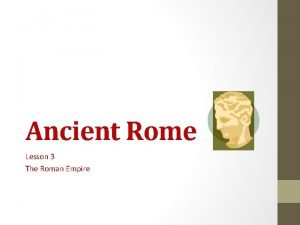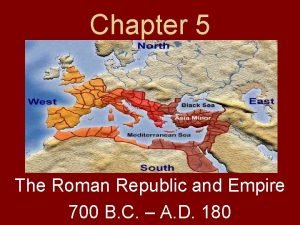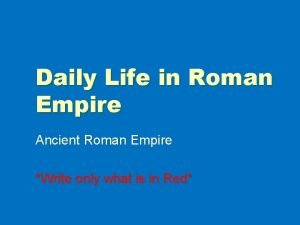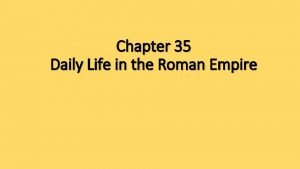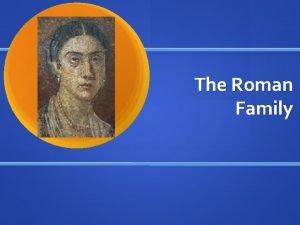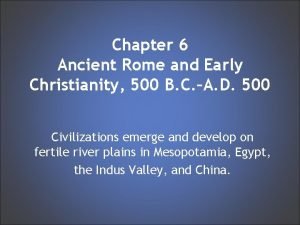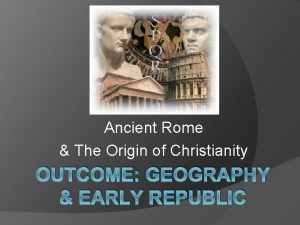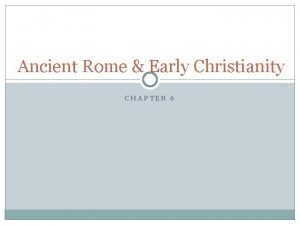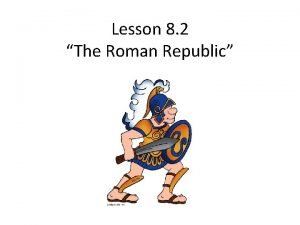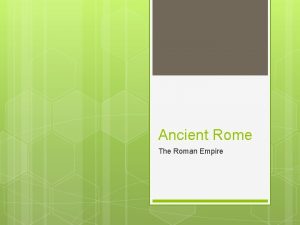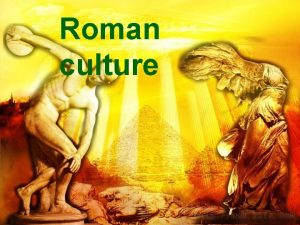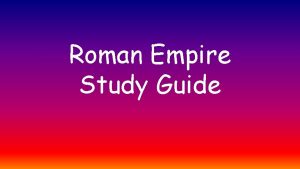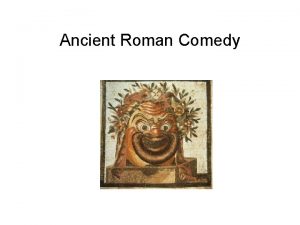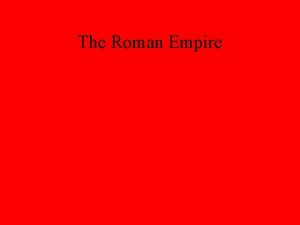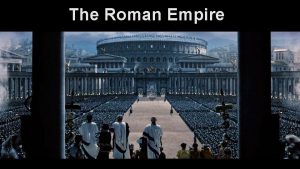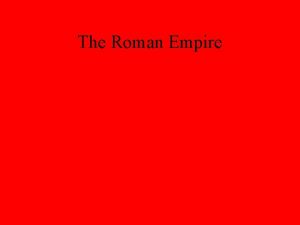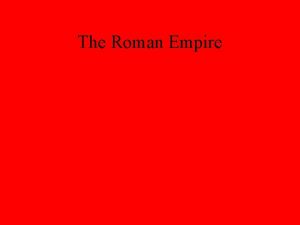Roman Empire The Early Empire Life in Ancient














- Slides: 14

Roman Empire The Early Empire Life in Ancient Rome The Fall of Rome

What did Augustus achieve? For centuries the Mediterranean region had been filled with conflict – he began to get it under the control of one empire How did he do that? 150, 000 professional soldiers 9, 000 Praetorian Guard (notice the root word, I wonder why it is praetor? )

What else? His legions conquered many new territories (Spain, Gaul (France), Austria, Hungary, Romania, and Bulgaria – map text p. 292 A. D. 14) Rebuilt Rome Stately palaces, fountains, splendid public buildings (“I found Rome a city of bricks and left it a city of marble”) see picture text p. 287 Arts flourished as never before

There’s more he did? Imported grain to feed population (less likely to cause trouble) Improved Rome’s government Proconsul (governor) for each Roman province (they replaced politicians who had been chosen by the Senate) Traveled to provinces to see how things are going

Changes made by Augustus (causes and effects) C: builds professional army - E: adds conquered territories to empire C: imported grain – E: reduced hunger C: new professional governors – E: improved local government C: tax collectors were made government workers - E: increased amount of money controlled by government

EQ #1 How did Augustus begin Pax Romana? Permanent professional army Restored Rome’s splendor Imported grain to feed the hungry poor Appointed a proconsul for each province Reformed tax system His armies conquered new territories

Who follows Augustus and how does that work out? A mixed bag of rulers – some good and others were very bad Caligula – mental illness caused him to act strangely and treat people cruelly (text p. 288) Nero – another vicious man, “fiddled while Rome burned” (text p. 288)

OK, so Nero’s dead and the “good emperors” are coming – what happens in between? Mt Vesuvius/Pompeii Time Traveler text p. 290 Linking Past and Present text p. 290 Google images of Pompeii/Mt. Vesuvius

What made the “good emperors” good? Agriculture flourished Trade increased Standard of living rose Though they overshadowed the Senate more than ever, they did not abuse their power Named trained officials to carry out their orders S rank these in order of importance – 4 corners for most important – defend why

Give me some details of what they did to help the people Trajan gave money to help poor parents raise and educate their children Hadrian made Roman law easier to understand apply Antoninus Pius passed laws to help orphans All of the emperors supported public building projects (arches, monuments, bridges, road, harbors, aqueducts)

How does it work for most people? Most people were farmers who grew olives, grapes, and grain (both small estates and latifundia) Others were artisans who traded with others inside and outside the Roman Empire A gap existed between rich merchants, shopkeepers, and skilled workers – and poor farmers and city dwellers

The empire becomes its largest Under the “good rulers” (Nerva, Trajan, Hadrian, Antoninus Pius, and Marcus Aurelius) the empire flourished Under Trajan it becomes its largest - spreading well beyond the Mediterranean including Britain in the north and part of Mesopotamia in the east – (see map p. 293) Hadrian realizes it is too big to manage and pulls troops back from most of Mesopotamia, in Europe he sets the empire’s northern borders at the Rhine and Danube Rivers – (see map p. 293, also built Hadrian’s wall - Exploring Hadrian’s Wall p. 292, google Hadrian’s Wall)

What keeps it all together? The empire was unified by: Roman law Roman rule Shared identity as Roman culture had been carried into every province by soldiers who protected the empire and by officials who were sent to govern. Romans were generous in granting citizenship 5 min Draw each & describe drawing to partner

EQ #2 What made the empire rich and prosperous? system of roads – 50, 000 miles long (oh of how they were made; reasons roads were important) seas – naval protection and ports allowed trade to flourish aqueducts common currency allows trade to be easy all throughout the empire standard system of weights and measures Rank in importance – 4 corners – defend why
 Lesson 3 the early roman empire
Lesson 3 the early roman empire Cursus honorum
Cursus honorum Roman republic vs roman empire
Roman republic vs roman empire Daily life roman empire
Daily life roman empire Daily life in the roman city
Daily life in the roman city Ancient rome family life
Ancient rome family life Early cpr and early defibrillation can: *
Early cpr and early defibrillation can: * Lesson 1 early civilizations
Lesson 1 early civilizations Ancient rome and early christianity chapter 6
Ancient rome and early christianity chapter 6 Early empires in the ancient near east
Early empires in the ancient near east Ancient rome outcomes geography and early republic
Ancient rome outcomes geography and early republic Ancient rome and early christianity chapter 6
Ancient rome and early christianity chapter 6 Ancient ways of communication
Ancient ways of communication Ancient india vs ancient china
Ancient india vs ancient china The best-known early roman dictator of the republic was
The best-known early roman dictator of the republic was
